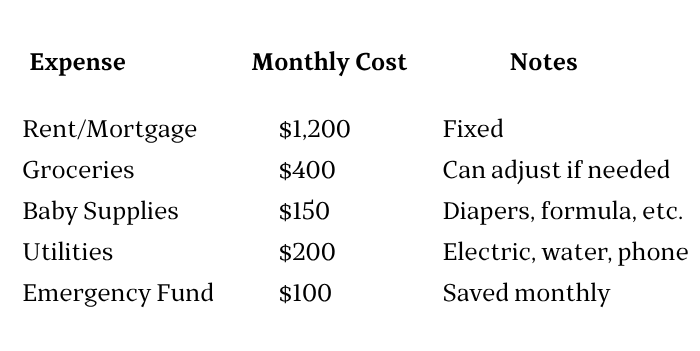Want to Stay Home with Your Baby? These 3 Steps Make It Possible
Many mums want to spend more time at home with their babies but aren’t sure how to make it happen. The good news is that staying at home with your little one is possible with the right approach. By planning carefully, building a strong support system, and finding flexible ways to earn income, we can make this dream a reality.

Adjusting to this new role takes time and effort, but it brings benefits for both mum and baby. When we create a space that supports our needs and explore options that fit our lifestyle, staying home becomes a fulfilling choice. This article will guide us through three simple steps to help us transition smoothly and enjoy this special time.
Key Takeways
Careful planning helps us prepare for the change.
A strong home environment supports our well-being.
Flexible income ideas help us maintain financial stability.
Understanding the Benefits of Staying at Home With Your Baby

Choosing to stay at home with our babies lets us build strong connections and support their growth. It also helps us care for our own feelings and manage our family’s money and time in ways that work best for us.
Bonding and Early Development
Spending a lot of time with our baby helps us form a close bond. When we hold, touch, and talk to our little one often, it supports their brain growth. Physical closeness can lower stress for both baby and us.
This kind of care can reduce chances of developmental delays. It also helps babies feel safe and loved, which is important in their first months and years. Studies show that steady attention from a parent can help babies grow emotionally and mentally strong.
Emotional Wellbeing for Mothers
Staying at home with our babies can improve how we feel. We get to watch them grow and share small moments every day. This can make us feel proud and more connected to our role as parents.
At the same time, it’s common to face challenges like feeling isolated or overwhelmed. It’s important we recognize these feelings and find ways to stay supported. Taking care of ourselves, asking for help, and keeping social ties helps keep our spirits up.
Financial and Lifestyle Considerations
Choosing to stay home affects how we manage money and daily life. Without a second income, we might need to adjust spending and budget carefully. This means planning for regular expenses and unexpected costs.
On the plus side, we save on childcare fees and commuting costs. We also get to create a flexible routine around our family’s needs. It’s good to weigh these details before deciding and make a plan that fits our situation well.
For more on the value of this choice, see benefits of stay at home parenting.
Step 1: Planning Your Transition to Stay-At-Home Motherhood
Before we make the leap to stay at home with our babies, it helps to carefully think through what our family truly needs. We also need to get clear about money and what changes to expect in our daily life. Planning these things well can make the transition smoother and less stressful.

Assessing Your Family’s Needs
We start by looking closely at our family’s daily routine and what support our baby and other family members need. This means thinking about childcare, meal times, sleep schedules, and how much help we have from partners or relatives.
It’s important to be honest about what we can handle alone and where we might need extra help. For example, do we need to arrange for babysitting on certain days? Can our partner share some kid-related tasks? Understanding what each family member needs makes it easier to build a practical routine that works for everyone.
Budgeting and Financial Preparation
Money is a big part of the plan. We should list all our monthly expenses and figure out how much money we’ll have without one income. This can include rent, groceries, bills, and baby supplies.
To get ready financially, we might need to cut non-essential spending or create an emergency fund for unexpected costs. It helps to create a simple budget table like this:

This way, we can see clearly if staying home is financially possible and where to make changes.
Setting Realistic Expectations
Staying at home with a baby isn’t easy, so we should expect ups and downs without getting frustrated. Our days will be very different from work life, with lots of unpredictable moments and less adult conversation.
We need to remind ourselves that feeling tired or overwhelmed is normal. Setting small daily goals, like spending quality time with the baby or resting during naps, helps keep things manageable. It also helps to have a few simple activities ready for ourselves and our child to keep the day varied and fun.
By planning this carefully, we prepare ourselves emotionally for the change ahead. For more insight on making this shift, we can check out tips at transitioning to stay-at-home mom.
Step 2: Creating a Supportive Home Environment
Making our home a calm and caring place helps us and our babies feel safe and happy. Setting clear daily plans, leaning on friends or family, and taking time for ourselves keeps everything balanced and stress low.

Organising Your Daily Routine
Having a simple routine keeps the day predictable and less overwhelming for both us and our baby. We can plan feeding, naps, and playtime around regular times. Using a chart or checklist helps us see what needs to be done without feeling rushed.
Clarinda the baby nurse can help establish routines and schedules to suit your lifestyle and help give you a little bit of your time back.
This structure gives our baby comfort and gives us control over the day. We stay flexible to change times based on our little one's needs.
Building a Support Network
Having support from others is key. We don’t have to do everything alone. Talking to family, friends, or other mums gives us advice and emotional support.
We can join local groups or online communities to connect with people who understand what we’re going through. Asking for help with chores or watching the baby even for a short time can give us much-needed breaks.
Being open about what we need makes it easier for others to step in. This support helps us feel stronger and less isolated.
Prioritizing Self-Care
Taking care of ourselves is just as important as caring for our baby. We need to find small moments for rest, healthy meals, and activities that relax us, like reading or gentle exercise.
Self-care isn’t selfish; it keeps us physically and mentally healthy. Even 10 minutes a day dedicated to ourselves can make a big difference. We should ask for help to take this time when needed.
Creating a home where both baby and parent feel cared for starts with making self-care a daily habit.
Learn more about building a nurturing home environment at how to create a safe and supportive home environment.
Step 3: Exploring Flexible Income Opportunities
Finding ways to earn from home while caring for babies is all about fitting work around our lives. We can choose jobs that let us control our hours, start businesses that match our skills, and create routines that support both work and family.

Finding ways to earn from home while caring for babies is all about fitting work around our lives. We can choose jobs that let us control our hours, start businesses that match our skills, and create routines that support both work and family.
Work-From-Home Jobs for Moms
There are many jobs designed to fit into our busy mom schedules. For example, we can do freelance writing, graphic design, customer service, or virtual assistance. These roles often offer part-time options and flexible hours, however we are still essentially trading our time for money in these roles. There are options to work remotely online where automations, systems and the right vehicle can all work around your lifestyle as a mum. I will share more about the vehicle i use to create an income online.
Online tutoring or teaching can also work if we have experience in a subject. Plus, we can pick the best times to work, maybe during naps or school hours.
When searching for work-from-home jobs, it helps to find ones with no strict office hours and clear payment terms. This way, we get paid fairly without sacrificing time with our little ones.
Starting a Home-Based Business
Launching a business from home lets us use our hobbies or skills to earn money. This could mean selling handmade crafts, offering coaching sessions, or starting an online store.
The key is to choose something we enjoy and that suits our time limits. For example, running an Etsy shop allows us to create products on our own schedule.
We should also plan how much time and money to invest upfront. Using social media can help us reach customers without spending much.
Tips for starting:
Research your market
Start small and test the idea
Use free or low-cost tools for promotion
Balancing Work and Family Life
Keeping a steady routine helps us handle work and family without too much stress. Setting clear work hours stops work from taking over family time.
We can plan breaks around feeding and playtime. It also helps to create a dedicated workspace, even if it’s just a small corner, to focus better.
Sharing responsibilities with partners or other family helps us find free moments. Prioritizing tasks and saying no to extra work when needed keeps everything manageable.
Using planners or apps to organize time can keep our days smooth and flexible. This balance is key to being productive while still enjoying our babies’ early years.
Long-Term Success as a Stay-At-Home Mum
Staying at home with our babies is a rewarding journey, but it also means balancing our roles as caregivers with our own needs. To thrive over time, we need to keep a clear sense of who we are and keep learning new things. These steps help us stay motivated and confident.
Maintaining Personal Identity
It’s easy to feel lost when most of our day focuses on the baby. We must find ways to keep our personal identity alive. That can mean setting aside time for hobbies we love or keeping up with old friendships.
Writing a journal, exercising, or reading can boost our confidence. Even small daily choices, like picking our own clothes or making time for a quiet cup of tea, remind us we’re more than just mums.
Talking about our feelings with other stay-at-home mums helps us stay connected. This support encourages us to see our value beyond parenting.
Continuous Learning and Growth
Being a stay-at-home mum doesn’t mean we stop learning. We can explore new skills that interest us, such as cooking, crafting, or even online courses.
Growing our knowledge keeps our minds active and prepares us for future plans, like returning to work or starting a small business.
Setting small goals every week helps us stay on track. For example:
Learn a new recipe
Read one chapter of a book
Join a local class or online group
Taking these actions creates a sense of progress and helps us feel proud. It’s not just about caring for our babies; it’s also about caring for ourselves as we grow.
For more ideas on motivation and balance, we can look into how mums stay active and connected during this time in our Parenting Village Facebook Group.
Frequently Asked Questions
We know balancing time, money, and daily tasks can feel challenging when staying home with little ones. It helps to understand the benefits, plan finances carefully, and create a flexible routine that fits your family’s needs.
What are the benefits of being a stay-at-home mom during my baby’s first year?
Being home with your baby lets us build a strong bond from the start. We can closely watch their growth and respond to needs quickly.
It also offers chances for breastfeeding, which supports our baby’s immune system and health. Plus, we get to create memories during those early, special moments.
How can I manage finances to afford staying home with my baby?
Budgeting is key. We focus on cutting non-essential expenses and prioritizing savings before the baby arrives.
Looking into government benefits or parental leave pay can also help support our household during this time.
Working on a simple plan for monthly spending gives us a clearer picture of what we can afford.
Can you suggest a daily schedule for a stay-at-home mom with an infant?
We start with feeding and diaper changes early in the day. Then, include some tummy time or gentle play when the baby is awake.
Rest is important too. We fit in naps for both baby and ourselves to keep energy up.
A flexible schedule works best since babies have changing needs.
What is a good routine for a stay-at-home mom with both an infant and a toddler?
We balance attention by setting quiet playtime for the toddler while feeding or napping with the infant.
Including simple activities for the toddler like reading or drawing keeps them engaged.
Try to have shared family moments, like walk times or snack breaks, so both kids feel connected.
Do you have any tips for creating a stay-at-home mom schedule when also managing school-aged children?
Homework, meals, and kids’ activities take up a lot of time. We schedule these around baby’s nap times to reduce disruptions.
Using visual schedules or charts helps older kids know what to expect and stay independent.
We also ask for help when needed to spread out the tasks.
How can a stay-at-home mom effectively organize her day with a 3-year-old?
Three-year-olds need play and learning. We mix structured activities like puzzles with free play to keep them interested.
Setting clear pockets of time for meals, naps, and outdoor play helps the day flow.
We make sure to keep time for quiet moments with the toddler to support their emotional needs.
Created with © systeme.io
